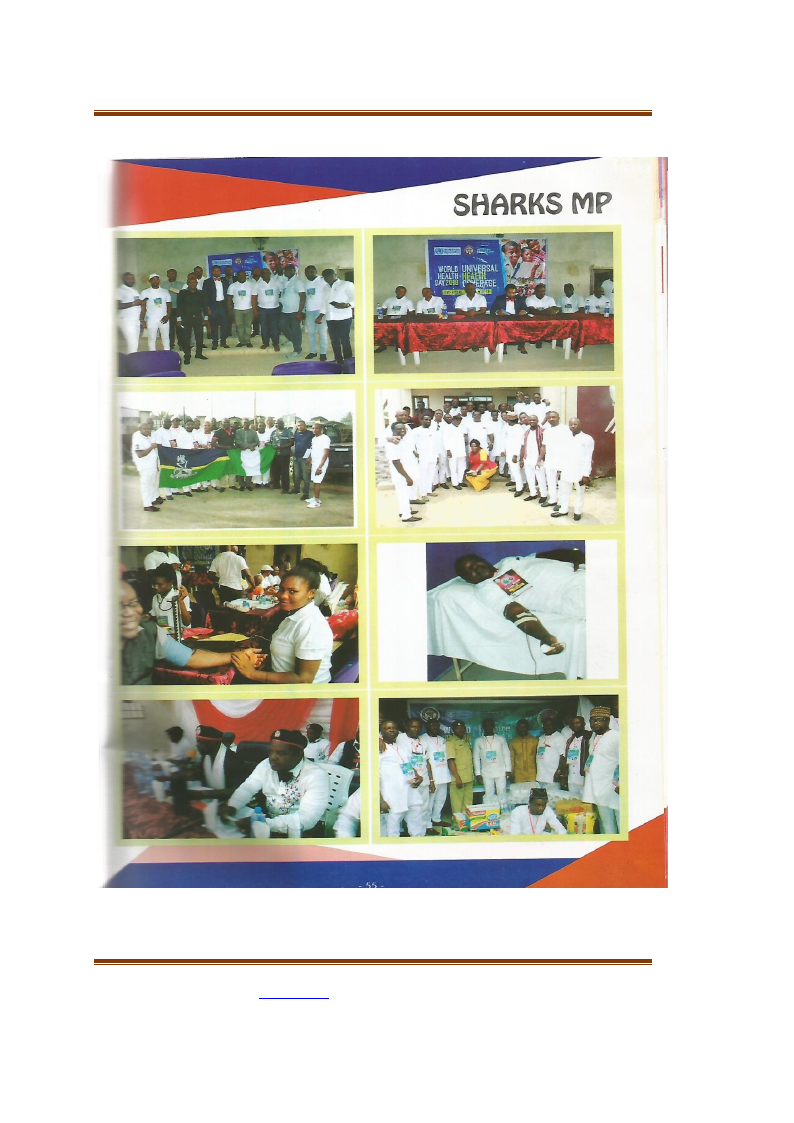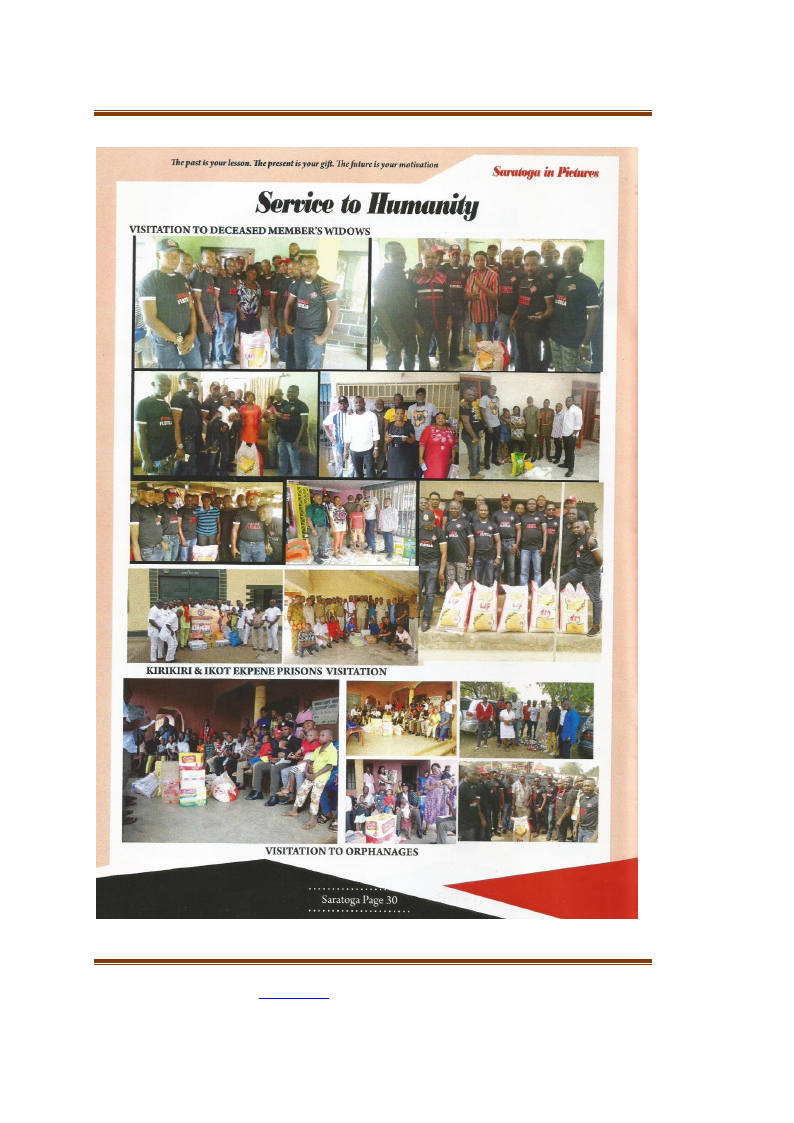
AFRREV VOL 14 (1), S/NO 57, JANUARY, 2020
African Research Review: An International
Multidisciplinary Journal, Ethiopia
AFRREV Vol. 14 (1), Serial No 57, January, 2020:106-118
ISSN 1994-9057 (Print) ISSN 2070-0083 (Online)
DOI: http://dx.doi.org/10.4314/afrrev.v14i1.10
Peace Building and Conflict Transformation in Nigeria: The Role of
De Norsemen Kclub Incorporated in an Environmentally Challenged
Society, 1982-2018
1Amiara, Solomon Amiara, Odii, Peace Udoamaka and Nwobi Obiora I.
Department of History and International Relations,
University, Abakaliki
Ebonyi State, Nigeria
E-mail: 1solomon.amiara@ebsu.edu.ng; sologanza@yahoo.com
Abstract
This paper examined the role of De Norsemen Kclub Incorporated in peace building and
conflict transformation in an environmentally challenged society like Nigeria. Over the years,
environmental crisis has become a re-occurring decimal that threatens the sovereignty of
Nigeria with the civil societies, religious leaders and nongovernmental organisations seeking
to proffer solutions. However, arguments have raged on whether or not De Norsemen has the
capacity to ensure peace and resolve conflict in a volatile country like Nigeria. Some are of
the opinion that De Norsemen Kclub lacks the legitimate powers to maintain peace because of
their inclination to school cult gangs and therefore, they should be proscribed. Other side of
the argument opines that De Norsemen Kclub Incorporated are legitimate organization
registered under the Corporate Affairs Commission whose motto is “service to humanity” and
since conflict is a threat to human security, they therefore have the powers to advocate for
peace. Against this background, this paper argued that peace building and conflict
transformation are concepts in conflict resolution strategies that are often taken to ensure that
conflicts in the society are deescalated and reduced to the barest minimal. The position of the
paper is that De Norsemen Kclub is not associated with any form of cultism, they operate
under the sovereign constitution of Nigeria and has right like other nongovernmental
organisations to make peace and resolve conflict in Nigeria.
Key Words: Peace building, conflict transformation, De Norsemen, environment, society
Introduction
Peace-building and conflict transformation are recent concepts in peace and conflict studies.
The two concepts are said to be closely related thus, they both work to ensure that there is a
COPYRIGHT © IAARR: https://www.afrrevjo.net
Indexed African Journals Online: www.ajol.info
Indexed Society of African Journals Editors (SAJE); https://africaneditors.org/
106

AFRREV VOL 14 (1), S/NO 57, JANUARY, 2020
conflict-free environment and society. In Africa, and every other part of the world, the history
of man is shrouded with conflict and since then, man has been at the epicentre of making
peace and creating conflict. This is because; man lives in an environment in which what gives
him happiness also causes him pains. This clearly shows that right from time, there exists a
competitive environment with scarce resources in which man needs to eliminate and
manipulate the ecosystem in order to satisfy his wants. By doing this, he becomes responsible
for making troubles and providing peaceful environment for advancing his needs. The
implication shows that humans are always looking for an opportunity for making peace and
creating conflict in the society and it is expected that when this conflict occurs measures
should be taken to avoid the escalation of the conflict. These measures include the resolution
of the conflict through peace-making, enforcement or by undertaking proactive measures such
as peace-building and conflict transformation that would stop the occurrence of the conflict at
the first instance.
By this, Folarin maintained that the field of Conflict and Peace Studies (CAPS) is not yet a
paradigmatic community. This is because, there is yet, no common agreement on the concepts
of peace and conflict since what creates peace can generate conflict. Scholars of social
conflict have often perceived conflict as an opposite of Peace however a study on peace and
conflict has revealed that peace can exist side by side with conflict. This implies that there are
instances in which there will be peace yet, there will be conflict (Odoh&Amiara, 2013, p. 1).
To this extent, conflict generally is not an opposite of peace but could be seen as a vice
because of its destructive capacity to human existence hence, conflict is not only destructive
but also constructive and it is the constructive aspect of conflict that often translates to
societal development thus, leading to building a standard state that will be value oriented.
In Nigeria, conflict has become part of the nation-building. There are conflicts arising from
ethnic marginalization, environmental degradation, political instability and religious crises.
Instances of these conflicts have shown that there are usually neutral bodies or organisations
that often undertake to stop the occurrence of conflict at its pre-conflict stage. For example, it
is important to understand that community leaders, women’s groups, journalists, businessmen
and women have demonstrated that their influences could extend beyond that of soldiers and
politicians. However, there are other bodies such as De Norsemen Kclub who have
demonstrated the capacity for complementing government efforts through the provision of
essential services and aids to the needy populations in order to ensure that conflicts within
their areas of operation are brought to halt.
Even though De Norsemen Klcub has over the years played a very significant role in peace-
building and conflict transformation, this role remains unnoticed especially as the De
Norsemen Kclub’s legality, legitimacy and value-free social organisation are yet to be
appreciated. There are people in some quarters who labelled De Norsemen “cultists” and the
others who opined that they are “gangsters” that operate within the provisions of law of the
Federal Republic of Nigeria which prevent them from being arrested. This school of thought
further holds that De Norsemen Klcub is a “cult gang” but a reformed cultist. This treatise is a
refutation of such assumption that De Norsemen is a “cult gang”, it is a social group that
seeks to promote unity in diversity and Nigerian cultures.
COPYRIGHT © IAARR: https://www.afrrevjo.net
Indexed African Journals Online: www.ajol.info
Indexed Society of African Journals Editors (SAJE); https://africaneditors.org/
107

AFRREV VOL 14 (1), S/NO 57, JANUARY, 2020
Conceptual Clarifications
Conflict Transformation
Conflict transformation is a product of Eastern Mennonite School of peace building that was
introduced by John Paul Lederach (1995). Conflict transformation however is a concept that
goes beyond conflict resolution. It is a process in which a long-standing relationship is built
through a process of change in perceptions and attitudes of parties. Its aim is to change the
parties, their relationships and the condition that created the conflict (2007, p. 95). By this,
Jeong (2000) maintained that conflict transformation entails the coming into being of new
situations involving conflict issues, perceptions, relationships and communication patterns.
Lederach (1995) saw conflict transformation as change. In fact, he opines that it can be seen
descriptively in the changes created by social conflict and prescriptively in the deliberate
intervention by third parties to create change. Conflict transformation is very important in the
resolution of conflict because it allows parties into conflict to work out modalities towards
changing conflicting environment to peaceful one. This ensures that individual or groups have
tendencies to positively change poorly functioning communication. The implication is that,
these changes can occur at personal or group level. In order words, this change at the personal
level, involves emotional, perceptual and spiritual aspects of change desired for the
individual. It is in this regard that conflict becomes part of man’s social life affecting his
relationship with people and other group relations. Coser(1956) conceived conflict as a
struggle over values and claims to scarce status, power and resources in which the aims of the
opponents are to neutralize, injure or eliminate their rivals (1956, p. 3).
Similarly, Dougherty and Pfaltralize (1981, p. 181), conceptualise conflict as a condition in
which one identifiable group of human beings...is engaged in conscious opposition to one or
more other identifiable groups because groups are pursuing what are or appear to be
incompatible goals. This implies that conflict is inevitable part of human existence. It is a
means and not an end itself to social development hence, Burton (1987, pp. 137-8),
maintained that conflict like sex is an essential creative element in human relationship. It is
the means to change, the means by which our social values of welfare, security, justice and
opportunities for personal development can be achieved ...indeed conflict like sex is to be
enjoyed.
Peace-Building
Peace building applies to a situation of a low conflict and high prospect for development. It is
a post-war reconciliation phenomenon that often emphasis that parties into conflict have the
capacity of establishing peaceful relationships through initiating joint community projects or a
third-party negotiating peace by dealing with issues that caused the war. Lederach (1994,
p.14), defined peace building as efforts to transform potentially violent social relations into
sustainable relations and outcomes. The 1986 International Conference on peace-building
defined the concept as “...a positive, continuous cooperative human endeavour to buildbridges
between conflicting nations and groups. It aims to enhance understanding and communication
and dispel the wandering roots of distrust, fear and hate” (International Conference on peace-
building, 1986).
Peace-building is expected to create attitudes, behaviours and structure which will make
future conflict improbable. For this reason, Halitza (1994) describes the term as the deliberate
and systematic build-up of interactions, dense and durable, initiating a state in which the
resumption of conflict would be improbable.Therefore, Harbottle (1985) identified the
COPYRIGHT © IAARR: https://www.afrrevjo.net
Indexed African Journals Online: www.ajol.info
Indexed Society of African Journals Editors (SAJE); https://africaneditors.org/
108

AFRREV VOL 14 (1), S/NO 57, JANUARY, 2020
physical reconstructive component of peace-building in a post-war environment when he says
that peace-building is a process of socio-economic reconstruction, development and
expansion in conflict scarred and deprived areas and among underprivileged people. The
implication of Harbottle’s definition of peace-building is that, the concept represents the
process in which the alleged fear of the parties into social conflict is proportionately reduced
in order to rebuild their confidence that conflict among them has been brought to halt. This
means that peace-building is more meaningful after the cessation of hostilities, and involves
things liking assisting refugees and displaced persons to return and resettle in their homes;
removal of abandoned mines especially in residential areas; provision of food, water, drugs
and clothing; activation of damaged electricity and water supply lines, organization of
elections, election monitoring, reconstruction of infrastructure like roads and bridges,
rebuilding of damaged schools and hospitals, retaining of army and police. Most importantly,
peace-building deals with the root causes of the conflict and relates to confidence building.
Peace-building has been defined in different ways by different scholars, institutions, agencies
and departments of peace. The term was first used in the 1970s by Johan Galtung (1996, p.
112) when he called for the creation of peace building structures as a process of promoting
sustainable peace by addressing the ‘root causes’ of violent conflict, and by supporting
indigenous capacities for peace management and conflict resolution. Since then, peace-
building assumed a dominant factor in the pursuit of global peace and security. Over the
years, scholars and institutions who have elaborated on the definition of peace building had
provided different meaning to the subject of peace-building. Thus, the United Nations
Secretary-General, Boutros Boutros-Ghali was in 1992 report, An Agenda for Peace, defined
peace building as an action to solidify peace and avoid relapseinto conflict (Boutros-Ghali,
1992). Therefore, Issifu (2015) the concept of peace building has different definitions by
several departments, institutions, schools, agencies and scholars. For example, Call and
Cousens (2007)), have defined peace building as those actions undertaken by international or
national actors to institutionalize peace, understood as the absence of armed conflict (negative
peace) and a modicum of participatory politics (as a component of positive peace) that can be
sustained in the absence of an international peace operation. Similarly, Porter (2007), defined
peace-building to mean all processes that build positive relationships, heal wounds, reconcile
antagonistic differences, restore esteem, respect rights, meet basic needs, enhance equality,
instill feelings of security, empower moral agency and are democratic, inclusive and just.
Therefore, peace psychologists have described peace building in terms of resolution, being
proactive, problem solving, meeting human needs, and ending oppression and inequality.
Peace-building therefore means a process of instilling cordial relationship and providing
environment that forestalls hostility in order to ensure peaceful co-existence. It means a long
and painstaking process which cannot be achieved in a hurry or within a fixed time limit.
Hence failure to recognize this may mean that resources, monies and hard-won improvements
are often wasted.
Nigeria and the Environmentally Challenged States
States in Nigeria have been and are still environmentally challenged by one conflict or the
other. These conflicts arose as a result of state or institutional failure. However, depending on
the region or locality one finds oneself, their operations, nature and causes vary as one takes
step towards investigating the cause, management and their resolution. From north to the west
and east to the south, there are conflicts taking place simultaneously and continued to threaten
Nigerian national security. There are Boko Haram and Fulani herdsmen crises in the North,
COPYRIGHT © IAARR: https://www.afrrevjo.net
Indexed African Journals Online: www.ajol.info
Indexed Society of African Journals Editors (SAJE); https://africaneditors.org/
109

AFRREV VOL 14 (1), S/NO 57, JANUARY, 2020
kidnapping activities in the West, farmers-herders conflict in the East and militant operations
in South-south. Government at all levels have sought to resolve these conflicts through
amnesty programme however, conflict entrepreneurs and actors have continued to cash in
from the mismanagement of the whole exercise to escalate the conflicts. These have
constituted serious security threats and made Nigeria haven for criminals. Moreover, policy-
makers, civil society and independent conflict mediators have one way or the other negotiated
peace and suggested measures to be taken towards ending these crises however; the crises
have continued to increase in forms on daily basis and thus, left many Nigeria to wonder
whether the Nigerian security agents are incapable of arresting the situation. Indeed, despite
corporate bodies, nongovernmental organizations and religious groups embarking on peace
education to sensitize and educate the populace on this menace, the crisis has continued
unabated as the actors have cited one reason or the other as the bane for the conflict.
In Niger Delta, the activities of oil companies in exploring crude resources have led to the
militarization and volatility of the region. This is not good for the security of Nigeria as
criminals are now in the possession of arms.
De Norsemen Kclub Incorporated
De Norsemen Kclub is a socio-cultural organization that is committed to the propagation of
unity in diversity mantra of the Federal Republic of Nigeria. It was born out of the burning
desire of young Nigerians who are committed to the maintenance of peace and preservation of
Nigerian cultural heritage. In fact, De Norsemen Kclub International is a worldwide
organization made up of brothers of like mind with the sole aim of bettering humanity and
members of the organization (Archorage Magazine, 2017, p. 2).It seeks to stick together and
foster the welfare of each individual member, the immediate communities and world at large.
De Norsemen Kclub Inc is a responsive organization of responsible men duly registered with
Cooperate Affairs Commission (CAC) RC7458 under the extent laws of Nigeria and foreign
countries (Archorage Magazine, 2018, p. 27).
The history of the Norsemen or Norse people dates back to the period of Nordic Stone Age of
about 1900 AD, they were referred as the North Germanic peoples of the Early Middle Ages
during which they spoke old Norse language and practiced old Norse religion (The
Norsemen, 2018). The language belongs to the Northern Germanic branch of the Indo-
European languages and it is the predecessor of the modern Germanic languages of
Scandinavia. The term Norsemen does relate to “Northman” which applied to Norse-speakers
by the people they encountered during the Middle Age (Nielson, 2006, pp. 584-86). Similarly,
the old Frankish word Northmann “Northman” was Latinised as Normannus and was used in
Latin texts. The Latin word Normannus then entered old French as Normands. From this
word, came the name of the Normans and of Normandy which was settled by Norsemen in
the 10th Century.
The word Norsemen first appears in English during the early 19th Century. It was coined
using the adjective Norse which was borrowed into English from the Dutch during the 19th
Century with the sense “Norwegian” and which by Scott’s time had acquired the sense of or
relating to Scandinavia or its languages in ancient or medieval times.
Organs and De Norsemen Kclub Leadership
De Norsemen Kclub Inc operates a very regimented lifestyle. It operates in the 36 states of the
federation including the FCT and has branches all over the world. Its headquarters is located
at River State called national headquarters. However, there are state branches known as “state
COPYRIGHT © IAARR: https://www.afrrevjo.net
Indexed African Journals Online: www.ajol.info
Indexed Society of African Journals Editors (SAJE); https://africaneditors.org/
110

AFRREV VOL 14 (1), S/NO 57, JANUARY, 2020
patrols” whereas the international branches are called “Diaspora Marine Patrols”. More so,
there are regional branches called “zones”. It operates in five organs otherwise known as the
components of Kclub. These include:
1. The Board of Trustees
2. The Sailyn Council
3. The National Executive Council
4. The Norsemen Advisory Council
5. The Patrols and Flotillas.
Beyond this organogram, the Kclub is headed by the international President with 7 other
officers who help to coordinate the activities of the Kclub during its congresses. The state
branches are headed by Guv’nors and 7 other officers while the zone branches are headed by
the directors appointed by the international president. It organizes two congresses of one
national and one international yearly. The leadership operates on two years tenure with the
option for re-election for another two years. The diagram below shows the organogram of De
Norsemen Kclub Incorporated
The International President General
Zones
The Vice National President
The National Treasure
States patrol
Flotillas
The Publicly Secretary
The National Provost
The National Welfare Officer
The National Legal Adviser
The Role of De Norsemen in Peace Building and Conflict Transformation
De Norsemen Kclub is an organization committed to fighting injustice. As a socio-cultural
organization, it is bound by common objective for pursuing peace and unity among its
members to the society at large. By this, the Constitution of the Norsemen Kclub maintained
that “we believe in God, Brotherhood of man, love and justice” hence the motto “service to
humanity” (De Norsemen Magazine, 2019, p. 1). The impact of their services to humanity all
COPYRIGHT © IAARR: https://www.afrrevjo.net
Indexed African Journals Online: www.ajol.info
Indexed Society of African Journals Editors (SAJE); https://africaneditors.org/
111

AFRREV VOL 14 (1), S/NO 57, JANUARY, 2020
over the world including UK, USA, China, Malaysia, India, Philippine, Belgium, Germany,
Turkey, Italy, Brazil, Cyprus, South Africa, Canada, Togo, UAE and Ghana are measurable.
This they do by giving aids to war effected people and equally, help to sensitize disputant
parties on the disadvantages of war hence their role in peace-building and conflict
transformation.
Peace-building and conflict transformation are post conflict reconciliatory strategies geared
toward ending the reoccurrence of conflict in a conflict environment. The Norsemen kclub
has pursued peace through number of programmes such as peace education, provision of
relief materials to physical challenged persons and indigent people in various states of the
federation. One of its objectives as captured in her constitution maintains that De Norsemen
Kclub is to engage in activities like talk-shows, symposium and communal development
programmes, seminars that will promote and encourage responsible national development
(en.m.wikipedia ).
In line with this datum, members of De Norsemen Kclub often hold seminars and public
lectures during their congresses to articulate and discuss pressing issues of government
policies with a view to suggesting to the government on how to address security challenges
and also ensure good governance. By this, Magnus Nze (2019) maintained that the convention
is when the members come together to discuss contemporary issues bordering on Nigeria and
the world at large, and at the end of the deliberations issue a communiqué on how to move the
nation forward. It is on this promise that the Cross River State and Ebonyi State chapters of
De Norsemen Kclub met to discuss on how to broker peace between the two warring Ukelle
of Yala Local Government of Cross River State and Mfuma of Izzi Local Government of
Ebonyi State. The effort was frustrated by irritant warriors and entrepreneurs that feed from
the crumbs of funds designated to prosecute the war. However, the war that started since
2005 is said to have claimed about 98 people with about 160 persons injured and 300 houses
torched (2019).
In River State, there have been persistent sensitization of the populace against
environmentally threaten society in other states of Niger Delta area. The campaign was to
advise the youth against causing crisis on streets of River State. Similarly, in Cross River
State De Norsemen Kclub supported the restructuring of Special Anti-Robbery Squad (SARS)
in combating crimes in the state. According to Sam Odoh,
In a reaction to the recent clamour for the disbandment of the Special Anti-
Robbery Squad (SARS) unit of the Nigerian Police Force in some parts
ofNigeria, members of the Cross River State Chapter of De Norsemen
Kclubtook to the streets of the historical city of Calabar on the 21st of
December 2017 in a peace demonstration in support of SARS and to call for
itsSustenance (Odoh, 2018, p. 12).
He further observed that they marched in collaboration with other association such as the
Public Community Relations Committee (PCRC) Cross River State Chapter, Civil Society
Organization, and members of the public.
In Ebonyi state, its members have worked with State Security Agents to fish out criminals in
the state. Crimes such as kidnapping, armed robbery, thuggery, rape and inter-cult conflicts
have reduced because of the peace education usually undertaken by De Norsemen Kclub,
Ebonyi State Chapter. In other states, public lectures that border on Nigerian economy,
COPYRIGHT © IAARR: https://www.afrrevjo.net
Indexed African Journals Online: www.ajol.info
Indexed Society of African Journals Editors (SAJE); https://africaneditors.org/
112

AFRREV VOL 14 (1), S/NO 57, JANUARY, 2020
security and politics are periodically conveyed to educate the general public and contribute
peace building in the country.
De Norsemen Kclub and the Service to Humanity
Another important role of De Norsemen Kclub to the society is her contributions and services
to humanity. As part of her objectives, De Norsemen designate every 15th October as De
Norsemen day. Being used to commemorate with the less privileges and internally displaced
persons Agughasi (2018, p. 7) maintained that for clarity, October has been chosen as a
historical and traditional month of festivals according to Nordic Mythology. While ‘The Day
15th’ was coined by counting letters in the word; De Norsemen Kclub, October 15th has now
become a day chosen to institutionalize services to humanity, a day set aside to mark
assiduous work to confront the evils and ills against humanity. In carrying out selfless
services to the downtrodden, members of the club all over the world often buy item materials
such as clothes, groundnut oil, palm oil, salt, magi, bags of rice, garri and other cooking items
to denote to the less privileges.
In 15 October, 2018, the Ebonyi State chapter of De Norsemen celebrated with the prison
inmates at the Abakaliki Prison Headquarters while her Cross River counterpart visited Prison
Headquarters Calabar. In the same vein, the Akwa Ibom State chapter denoted edible items as
well as disinfectants and toiletries to inmates of the Medium Security Prison in Ikot Ekpene
Local Government Area. This was preceded by a thanksgiving Service at Living Faith Church
(Winners Chapel) ItiamEdem Akai Assembly. In this regard, Umoh (2018: 22) notes that as
an organization whose motto is ‘service to humanity’ De Norsemen Kclub remains committed
to serving the society and giving hope to the hopeless and defense to the defenseless. In
Lagos, the Lagos state chapter visited KirikiriPrsion while the Oyo state chapter visited
Rosarian Home to commemorate abandoned people in Ibadan North Local Government Area.
There was also free medical screening exercise to the residents of Akpasak Estate community
in Uyo and in June 2018, members of De Norsemen were in Immanuel General Hospital,
Eket, to make free and voluntary blood donation to the medical facilities.
In 2019, state chapters of De Norsemen all over Nigeria visited orphanage homes, IDP camps,
hospitals, widow care and distributed different kinds of material to the less privileges. In
Ebonyi State, the Kclub members were seen along Ogoja Road in the State capital sharing
food to destitute on 15th October, 2019 before proceeding to commemorate with the wife of
their deceased organizing secretary in which they presented a cheque of four hundred
thousand to her.
Below is the picture of some humanitarian services rendered by De Norsemen Klcub to
indigent persons including the destitute and prisoners in Nigeria
COPYRIGHT © IAARR: https://www.afrrevjo.net
Indexed African Journals Online: www.ajol.info
Indexed Society of African Journals Editors (SAJE); https://africaneditors.org/
113

AFRREV VOL 14 (1), S/NO 57, JANUARY, 2020
COPYRIGHT © IAARR: https://www.afrrevjo.net
Indexed African Journals Online: www.ajol.info
Indexed Society of African Journals Editors (SAJE); https://africaneditors.org/
114

AFRREV VOL 14 (1), S/NO 57, JANUARY, 2020
COPYRIGHT © IAARR: https://www.afrrevjo.net
Indexed African Journals Online: www.ajol.info
Indexed Society of African Journals Editors (SAJE); https://africaneditors.org/
115

AFRREV VOL 14 (1), S/NO 57, JANUARY, 2020
Conclusion
Peace-building and conflict transformation are important strategies of conflict management.
However, Conflict management is best understood as any effort to control or contain an
ongoing conflict between politically motivated actors operating at the state or sub-state level,
typically through involvement of a third party (1990, p. 2). It is centrally concerned with
making an ongoing conflict less damaging to the parties directly engaged in it. In order words,
conflict management is a process in which government, civil society or parties into conflict
decide to embark on programmes that could lead to peaceful co-existence. In crisis situation,
peace building is important because it leads to confidence building, removal of suspicion to
ensure social harmony, unity and cooperation among the conflicting parties. Building peace
relates to conflict transformation which has to do with the de-escalation of the conflict
situation.
In Nigeria, environmental conflicts have provided a litmus test of an area with high degree of
conflicts. These conflicts have been managed in number of ways by different governmental
organisations, corporate organisations and parties. One of those organisations is De Norsemen
Kclub, established in Nigeria in 1982 at University of Port Harcourt by young men with
proven character bound by religio-cultural values, objectives and obedient to the supreme law
of the Federal Republic of Nigeria. Since then, this organisation has contributed towards
translating conflict environment to pro-peace environment. By doing that, they organize
converges, seminars and public lectures where peace education is carried to all corners of the
country. It is to this extent that Ogar Egbe (2018, p. 18) noted that in today’s world, we have
some big problems facing the human race. The threats of global warfare, destruction of the
environment, global warming, over population and totalitarianism are just a few of the
problems we as Norsemen are going to solve if we are going to survive the rapidly
approaching new era.
In achieving these objectives, De Norsemen Kclub has contributed in different ways to ensure
that conflicts in Nigerian environment are de-escalated so that peace and security among
Nigerians will be ensured.
References
Abani, L. A. (2017). The ship in diaspora, challenges and solutions. Anchorage: Vol.
018, p. 2. Calabar: A Publication of the De Norsemen Kclub Incorporated.
Agughasi, I. (2018). The chronicle of Zilona: The leadership patrol. Calabar: A
Publication of the Cross River State Chapter of De Norsemen Kclub
Incorporated Vol.1, pp.7-8.
Anugom, D. (2018). Please be mindful of fraudulent tendencies, Norsemen Kclub
does not advertise for membership. Anchorage Magazine, Vol. 018: May,
2018, 27.
Best, S. G. (2007). Methods of conflict resolution and transformation. In Best, S. G.
(ed.) Introduction to peace studies in West Africa. Ibadan: Spectrum Books
Limited.
Burton, J. (1972). World Society.Cambridge and New York, Cambridge University
Press.
COPYRIGHT © IAARR: https://www.afrrevjo.net
Indexed African Journals Online: www.ajol.info
Indexed Society of African Journals Editors (SAJE); https://africaneditors.org/
116

AFRREV VOL 14 (1), S/NO 57, JANUARY, 2020
Boutros-Ghali, B. (1992), An agenda for peace: Preventive diplomacy, peacemaking
and peacekeeping. New York: United Nations.
Burton, J. & Dukes, F. (1990). Conflict practices in management, settlement and
resolution. New York, NY: St Martin’s Press.
Call, C. & Cousens, E. (2007). Ending wars and building peace.Working Paper
Series: Copping with crisis, p.173. New York: International Peace Academy,
Christie, D. (1997). Reducing direct and structural violence: The human needs theory:
Peace and conflict. Journal of Peace Psychology, Vol.3 (4), pp.315-32.
Coser, L. A. (1956). The foundations of social conflicts. New York, Free Press.
Dougherty, J. &Pfaltzgraf, R. (1981). Contending theories of international relations:
A comprehensive survey. New York: Harper and Row.
Galtung, J. (1996). Peace by peaceful means: Peace and conflict, development and
civilization. London: Sage.
Halitza, M. (1994). The improvement of effectiveness of United Nations peace-
keeping. UNITR, 238, p.174.
Harbottle, M. (1985). The United Nations and its capacity for keeping the peace,
fellowship. Briefing Paper, No. 4, UK, 4.
Issifu, A. K. (2015). Exploring indigenous approaches to peace-building: The case of
Ubuntu inSouthAfrica.Peace Studies Journal, Vol. 8(8), pp.59-72.
Jeong, H-Won (2000). Peace and conflict studies: A introduction. Aldershot: Ashgate.
Lederach, J. P. (1994). Peace building: Sustainable reconciliation in divided societies.
Tokyo: United Nations University Press.
Lederach, J. P. (1995). Preparing for peace: Conflict transformation across cultures.
New York: Syracuse University Press.
Odoh, I. S. &Amiara, S. A. (2013). Conflict and propaganda as tools for foreign
policy: The dividing line. African Journal of American Studies vol 3, No 2,
pp.1-6.
Odoh, S. (2018). Norsemen march in support of SARS. Calabar: A Publication of the
Cross River State Chapter of De Norsemen Kclub Incorporated Vol.1, p. 12.
Ogar Egbe, O. (2018). Creativity’s role in service to humanity: A Norsical viewpoint.
Calabar: A Publication of the Cross River State Chapter of De Norsemen
Kclub Incorporated, Vol.1.
OED online (2018). Norsemen n’ Norse n’ and ajd. Oxford University Press.
Accessed 5/9/2019 from http://www.oed.com/view/entry/128326. .
Nielsen, M. L. (2006). Review of Rune Palm VikingamasSprak 750-1100.
HistoriskTidskriff 126, p. 3.
COPYRIGHT © IAARR: https://www.afrrevjo.net
Indexed African Journals Online: www.ajol.info
Indexed Society of African Journals Editors (SAJE); https://africaneditors.org/
117

AFRREV VOL 14 (1), S/NO 57, JANUARY, 2020
Nze, M. (2019). Why DSP, ChidobeEKeleme of Enugu State Police Command is
after Us-De Norsemen Kclub International. Accessed on 12/09/2019 from
hpps://mikkydiamond.blogspot.com/2019/09/why-dsp-chidobe-ekelem-of-
enugu-state.html.
Porter, E. (2007). Peace-building: Women in international perspective. London:
Routledge.
Umoh, D. (2018). World Humanitarian Day: Norsemen visit Ikot Ekpene Prison,
donate edibles toiletries, others. Calabar: A Publication of the Cross River
State Chapter of De Norsemen Kclub Incorporated Vol.1, p. 22.
Wikipedia the Free Encyclopedia (2019). De Norsemen Kclub of Nigeria. Retrieved
from https://www.en.m.wikipedia.org/wik.
Wodu, A. & Nnachi, E. (2019). Constant agony as Cross River/Ebonyi communities
continued deadly clashes over land, in Punch Newspaper. Retrieved from
http.www.punchng.com
COPYRIGHT © IAARR: https://www.afrrevjo.net
Indexed African Journals Online: www.ajol.info
Indexed Society of African Journals Editors (SAJE); https://africaneditors.org/
118
